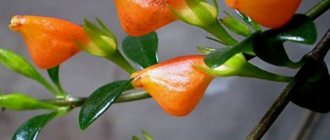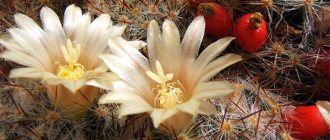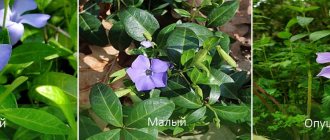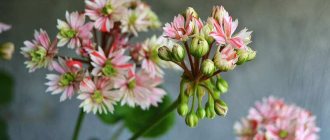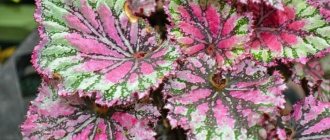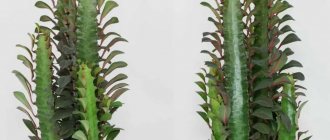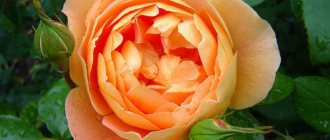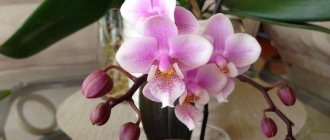| Oncidium stacyi | ||
| Scientific classification | ||
| intermediate ranks Domain: | Eukaryotes | |
| Kingdom: | Plants |
| Department: | Flowering |
| Class: | Monocots[1] |
| Superorder: | Lilianae |
| Order: | Asparagusaceae |
| Family: | Orchids |
| Subfamily: | Epidendral |
| Tribe: | Cymbidieae |
| Subtribe: | Oncidiinae |
| Genus: | Oncidium |
| View: | Oncidium stacyi |
| TPL | [www.theplantlist.org/tpl1.1/search?q=Oncidium+stacyi ???] |
K:Wikipedia:Articles without images (type: not specified)
Oncidium stacyi
(possible Russian names:
Oncidium Stacy
, or
Oncidium station
) is a perennial epiphytic herbaceous plant from the genus Oncidium - Oncidium of the Orchid family, or Orchidaceae (
Orchidaceae
).
Etymology and history of description
The species does not have an established Russian name; in Russian-language sources, the scientific name Oncidium stacyi is usually used. English name: Stacy's Oncidium.
The plant was discovered near the Bolivian city of Santa Cruz (Santa Cruz de la Sierra). Discoverer: Rene Luis Moreno. The species was described by botanist Leslie Garay, and the plant was named after his friend John Stacy. The description of the species and its commercial use caused lively controversy and scandal among specialists, which was reflected in the number of synonyms for its scientific name and played up by the writer Susan Orlean in one of her novels. Currently, Oncidium Stacy is the symbol of the Santa Cruz Orchid Club[2].
How does a flower reproduce?
A flower growing at home reproduces well by bulbs or by dividing a bush . Both methods are simple and fairly easy.
Dividing the bush
It is advisable to carry out the event if more than seven pseudobulbs have appeared, because a flower on which there are three pseudobulbs can already grow and develop . Division is done by cutting the bush with a disinfected tool.
After this, the sections are treated with crushed coal . Each cut piece of the plant must be planted in dry soil. The shoots do not need to be watered for 10 days so that the cut points do not begin to rot. Transplantation should be carried out in early spring.
Habitat, ecological features
Bolivia, Peru.
On trees and thorny bushes. The average annual temperature is 21-24 °C. The greatest amount of precipitation falls in January - February. Seasonal temperatures in the Santa Cruz area
| Spring | Summer | Autumn | Winter |
| 18 °C - 33 °C | 22 °C - 38 °C | 20°C - 30°C | 8 °C - 29 °C |
| September 21 – December 20 | December 21 – March 20 | March 21 – June 20 | June 21 – September 20 |
Oncidium Stacey is a protected species (II Appendix CITES). The number of places where this species grows is steadily declining, as about 300,000 hectares of forests are cut down in Bolivia every year.
Oncidium orchid propagation
At home, only vegetative propagation is possible. During transplantation work, the mother plant is divided into parts, cutting the rhizome with a disinfected sharp instrument so that each section contains at least 2, and preferably 3, pseudobulbs. The cut areas are sprinkled with crushed charcoal. After being planted in separate pots, young plants are not watered for several days, and then cared for as with adult specimens.
The seed method is used only in greenhouse laboratories with the necessary sterility. It is interesting for breeding because it provides the opportunity to obtain orchids with unusual patterns on the petals and lips.
Notes
- For the convention of indicating the class of monocots as a higher taxon for the group of plants described in this article, see the section “APG Systems” of the article “Monocots”.
- [www.mombu.com/orquideas/fotos-de-orquideas-y-floraciones/t-la-historia-de-la-oncidiun-stacyi-garay-20495.html History of the discovery of Oncidium stacyi
] - [www.orchidspecies.com/oncsacyi.htm Oncidium stacyi
species sketch on the Internet Orchid Species Photo Encyclopedia]
Soil, planting and replanting oncidium at home
Block (bark) and soil for oncidium orchid:
For cultivation, only special soil mixtures for orchids are used. For oncidium, fine bark is more suitable, so especially large pieces should be broken. If the flower shop does not have special soil in stock, you can make it yourself by mixing pine bark, high-moor peat and adding more charcoal and sphagnum moss.
A large piece of pine bark is used as a block. The roots of aganisia are tightly wrapped in sphagnum moss mixed with coconut fiber, and the layer of substrate should not be too thick. The orchid is well secured with wire on a block.
Proper transplantation of oncidium orchid:
The orchid reacts extremely negatively to replanting, so it should be disturbed only as a last resort, for example, if the substrate has become very crushed, has turned to dust, or the plant has become very cramped in the pot.
The pot for oncidium should be low, wide, or not transparent, since there is no chlorophyll in the root system. If you purchased a tall pot, it is better to fill ½ of it with drainage. Place a couple of heavy stones on the bottom for stability, then add a thick layer of drainage and a layer of fresh soil, and only then transfer the orchid itself, filling all the voids with new substrate.
Oncidium is a sympoidal plant, which means that it has several growing points, but shares a rhizome with them. The growth of young shoots is directed only in one direction. Therefore, it is planted closer to one side of the pot, and the old pseudobulbs are turned towards the wall. This frees up space in the pot for young shoots. If, during transplantation, there are already young shoots, they are turned to the center of the pot.
When planting, oncidium pseudobulbs are not buried in the substrate; they must be on the surface, otherwise they may begin to rot. Young pseudobulbs grow like a ladder, resulting in the formation of a hill. In other words, only the roots of the orchid are in the substrate.
Keep in mind that you need to pick up the orchid carefully, trying not to damage its bulbs. Removing old bulbs is not recommended because they will continue to feed the plant.
Oncidium cirrhosum. ©阿橋HQ
Literature
- Icones Planetarum Tropicarum plate 572 Dodson 1982 as Oncidium wittii.
- Icones Orchidacearum Peruviarum Plate 535 Bennett & Christenson 1998.
- Orchid Species Culture: Oncidium, Bakers 2006 as Cohniella stacyi.
- The Pictoral Encyclopedia of Oncidium Zelenko 2002 as Trichocentrum stacyi.
- Ibisch, P. L. 1996. Neotropische Epiphytendiversitat - das Beispiel Bolivien. Arch. Naturwiss. Diss. 1: 1—357.
- Navarro, G. 2001. Contribución al conocimiento fitosociológico de la vegetación de epifitos vasculares del centro y sur de Bolivia. Revista Boliviana Ecol. Cons. Amb. 10: 59-79.
- Moreno A., Revista de la Sociedad Boliviana de Botánica 4(1): 131–138, Editorial FAN, 2003.
- Vásquez R., Dodson, C. H. 1983. Orchids of Bolivia. Icones Plantarum Tropicarum, plate 572.
- Navarro, G., M. Maldonado, 2.002. Geografía Eológica de Bolivia, Editorial Centro de Ecologia Simon I. Patiño, Santa Cruz 2005.
Links
- [www.orchidspecies.com/oncsacyi.htm Oncidium stacyi
species sketch on the Internet Orchid Species Photo Encyclopedia] (English) - [www.tropicos.org/name/23509131 Oncidium stacyi
at Tropicos.org. Missouri Botanical Garden.] (English) - [www.preservando.com/tstacyi-3/ Oncidium stacyi
species profile on preservando.com] - [www.mombu.com/orquideas/fotos-de-orquideas-y-floraciones/t-la-historia-de-la-oncidiun-stacyi-garay-20495.html History of the discovery of Oncidium stacyi
] - [www.flickr.com/search/?w=all&q=Oncidium+stacyi Photos of Oncidium stacyi on flickr.com] (English)
| This is a draft article on botany. You can help the project by adding to it. |
Growing problems:
- Instead of a peduncle, a shoot grew. This happens if:
- The plant has less than 3 pseudobulbs, which means that the orchid simply does not have enough strength to bloom;
- Irregularities in care during the plant's dormant period;
- Oncidium foliage is too dark green if the plant does not have enough light;
- The foliage is too pale, small red spots indicate that the plant is suffering from too intense lighting;
- Pseudobulbs shrink as a result of poor watering. Wrinkling of the bulbs occurs during the dormant period, during the flowering period, when the young shoot begins to grow - this is quite normal.
Views: 1,089
Excerpt characterizing Oncidium stacyi
The plate did not seem clean to him; he pointed to the spot and threw it. Tikhon picked it up and handed it to the barman. The little princess was not unwell; but she was so insurmountably afraid of the prince that, having heard how out of sorts he was, she decided not to go out. “I’m afraid for the child,” she said to m lle Bourienne, “God knows what can happen from fright.” In general, the little princess lived in Bald Mountains constantly under a feeling of fear and antipathy towards the old prince, which she was not aware of, because fear was so dominant that she could not feel it. There was also antipathy on the part of the prince, but it was drowned out by contempt. The princess, having settled down in the Bald Mountains, especially fell in love with m lle Bourienne, spent her days with her, asked her to spend the night with her, and often talked to her about her father-in-law and judged him. “Il nous arrive du monde, mon prince,” said M lle Bourienne, unrolling a white napkin with her pink hands. – Son excellence le prince Kouraguine avec son fils, a ce que j'ai entendu dire? [His Excellency Prince Kuragin with his son, how much did I hear?] - she said questioningly. “Hm... this boy of excellence... I assigned him to the college,” the prince said offended. “Why son, I can’t understand.” Princess Lizaveta Karlovna and Princess Marya may know; I don’t know why he’s bringing this son here. I don't need it. – And he looked at his blushing daughter. - Unwell, or what? Out of fear of the minister, as that idiot Alpatych said today. - No, mon pere. [father.] No matter how unsuccessfully M lle Bourienne found herself on the subject of conversation, she did not stop and chatted about greenhouses, about the beauty of a new blossoming flower, and the prince softened after the soup. After dinner he went to his daughter-in-law. The little princess sat at a small table and chatted with Masha, the maid. She turned pale when she saw her father-in-law. The little princess has changed a lot. She was more bad than good now. The cheeks sank, the lip rose upward, the eyes were drawn downwards. “Yes, it’s some kind of heaviness,” she answered when the prince asked what she felt. - Do you need anything? - No, merci, mon pere. [thank you, father.] - Well, okay, okay. He went out and walked to the waitress. Alpatych stood in the waiter's room with his head bowed. – Is the road blocked? - Zakidana, your Excellency; Forgive me, for God's sake, for one stupidity. The prince interrupted him and laughed his unnatural laugh. - Well, okay, okay. He extended his hand, which Alpatych kissed, and walked into the office. In the evening Prince Vasily arrived. He was met at the prespekt (that's the name of the avenue) by coachmen and waiters, who shouted and drove his carts and sleighs to the outbuilding along a road deliberately covered with snow. Prince Vasily and Anatoly were given separate rooms. Anatole sat, having taken off his doublet and resting his hands on his hips, in front of the table, at the corner of which he, smiling, fixed his beautiful large eyes intently and absent-mindedly. He looked upon his entire life as a continuous amusement that someone like that for some reason undertook to arrange for him. Now he looked at his trip to the evil old man and the rich ugly heiress in the same way. All this could have turned out, he supposed, very well and funny. Why not marry if she is very rich? It never interferes, Anatole thought. He shaved, perfumed himself with care and panache, which had become his habit, and with his innate good-natured, victorious expression, holding his handsome head high, he entered his father’s room. Two valets were busy around Prince Vasily, dressing him; he himself looked around animatedly and nodded cheerfully to his son as he entered, as if he were saying: “So, that’s exactly what I need you for!” - No, no joke, father, is she very ugly? A? – he asked, as if continuing a conversation he had had more than once during the trip. - That's enough. Nonsense! The main thing is to try to be respectful and reasonable with the old prince. “If he scolds, I’ll leave,” said Anatole. “I can’t stand these old people.” A? – Remember that everything depends on this for you. At this time, the arrival of the minister with his son was not only known in the maiden's room, but the appearance of both of them was already described in detail. Princess Marya sat alone in her room and tried in vain to overcome her inner agitation.
GENERAL INFORMATION:
Oncidium Twinkle is a hybrid whose parents are Oncidium cheirophorum and Oncidium ornithorhynchum. The plant is quite compact, the size of the flowers is about 1.5 cm.
Depending on the color option there are:
- Oncidium Twinkle 'White Fantasy'
- white; - Oncidium Twinkle 'Fragrance Fantasy'
- pale yellow; - Oncidium Twinkle 'Red Fantasy'
- soft pink.
TEMPERATURE:
This hybrid belongs to a moderate temperature regime, but can easily adapt to both warmer and colder temperatures. It is recommended to keep plants under the following conditions throughout the year:
Summer:
20-24 °C (not higher than + 32 °C) during the day and about + 18 °C at night;
Winter:
+ 18 °C during the day and 14-15 °C at night.
To successfully grow Oncidium Twinkle at home, it is necessary that the night temperature is always 2-4 °C lower than the daytime temperature. For example, if during the day it is + 22 °C, then at night it is no more than 18-20 °C.
AIR HUMIDITY:
Oncidium Twinkle does not require extremely high air humidity, and its level can vary from 40 to 60%. Too dry air has a negative impact on the overall development of the plant - its growth is inhibited, resulting in deformations in the form of jammed "accordion" growth. To increase air humidity, you can use a humidifier, saucers of water, or wet expanded clay. To do this, take a large tray, inside which expanded clay is poured, a lattice is placed on top to prevent waterlogging of the roots, and pots with orchids are placed. When caring for this type of orchid, the following rule applies: “The higher the thermometer rises, the higher the air humidity should be, and the higher the air humidity, the more often and longer it is necessary to ventilate the room where the orchids are kept, otherwise there is a high probability of rotting and the appearance of leaves of various types of fungal diseases (more details...).”
SUBSTRATE:
This hybrid is grown both in a substrate (in ordinary plastic pots) and without it (placed on blocks). The best substrate is a mixture of coniferous tree bark (Italian pinia pine) with peat and a small proportion of sphagnum moss (10-15%). When growing orchids on blocks, to prevent the root system of the plant from drying out quickly, it is recommended to make a small layer of moss between it and the block. You can also put live or dry sphagnum on top of the roots.
TRANSFER:
Frequent replantings are not required for this hybrid, so it is advisable to replant Oncidium Twinkle only in cases where the substrate is highly salinized, its pH is critically low or high, or when the plant grows very much and the old pot becomes too small for it. The best time for replanting is considered to be the period when the new shoots reach a size of 5 cm and begin to grow their own roots (more about replanting...).
LIGHT:
This hybrid is grown both in bright diffused light and in partial shade. Windows with an eastern orientation are considered the ideal location; however, if there are none in the apartment, then western or very light northern windows can be used. Oncidium Twinkle equally does not like a place that is too dark (the orchid simply will not bloom here) or a place that is too light (the orchid leaves may burn). If western or southern windows were chosen as the location of the plant, then from May to early September the orchid must be protected from exposure to too bright daytime and evening sun - placed behind a curtain (for example, on a table near the window) or in the shade of other plants.
WATERING:
Watering this hybrid directly depends on the temperature; the higher it is, the more often and more abundantly it needs to be watered. When watering, excess water should flow freely from the pot, since stagnation of water both inside the pot and in its tray can very quickly lead to rotting of the roots) and the lower part of the plant. The damaged root system is not able to absorb water and transport it further inside the plant; from lack of moisture, the leaves and pseudobulbs of the orchid begin to wither and the plant slowly dies.
The substrate should DRY WELL between waterings. In other words, you need to water the orchid only when the substrate (in which it grows) is completely dry. You should not focus on a certain number of days - this is fundamentally wrong, since the speed of drying of the substrate is influenced by too many factors, such as illumination, the general temperature of the plant, air humidity, etc. Today the orchid will dry out in 7 days, and next time in just 2 days, and then cloudy days will begin, and the substrate will dry out for at least 20 days. In addition, the substrate dries out extremely unevenly; most often it happens that the top layer is already completely dry, but in the middle of the pot it is still very, very wet. You need to focus, firstly, on the total weight of the pot. Remember offhand how much a pot with a just watered orchid weighs, and as soon as it (again offhand) becomes half as light, you can safely water it. Secondly, try to pick at the top layer of the substrate and check with your finger how things are going inside.
It is best to water this hybrid using a “hot” shower (water temperature 30-35 °C, maximum 52 °C). This imitates the natural conditions in the orchid’s homeland and has a beneficial effect on the growth and development of the plant. Many years of practice have shown that with regular use of a hot shower, orchids not only grow green mass well, but also bloom much more often.
FEEDING:
Throughout the year, this hybrid is fertilized every third watering in the usual fertilizer concentration indicated on the package. The fertilizer must be used specialized, marked on the package “For orchids”, since conventional fertilizers for indoor plants are oriented for use in ordinary soil and when used in bark-based substrates, most of the salts settle as dead weight in the substrate itself, creating an unfavorable environment for the root plant. orchid systems environment, leading over time to their massive burning. At the beginning of the period of new growth (vegetation), it is advisable to use a fertilizer with a higher nitrogen content, and closer to the formation of pseudobulbs - a fertilizer with a higher phosphorus content. The process of feeding the plant is as follows: pour the required amount of fertilizer into a basin or bucket of water and place the pot with the orchid for 20-30 minutes. To avoid burning the root system of the plant, it is advisable to use filtered or regular water, well diluted with distilled water (in a 1:1 ratio).
REST PERIOD:
According to the natural features in the homeland of the parents of this hybrid, in winter Oncidium Twinkle undergoes a short period of rest, when the orchid is kept at a temperature no higher than + 18 °C during the day and about 14-15 °C at night and is watered somewhat less. Watering the orchid must be organized in such a way that between waterings the substrate not only dries well, but also remains completely dry for 1-2 days. At the beginning of March, the dormant period ends: the general temperature rises, and watering the orchid resumes in the usual volume.
BLOOM:
Oncidium Twinkle can bloom at any time of the year, especially preferring the autumn period. Flowering duration is at least one month.
AFTER FLOWERING:
After flowering, the Oncidium Twinkle peduncle is removed, if necessary, the orchid is replanted and kept completely dry for some time. This is necessary to acclimatize the plant and to prevent rotting of wounds on the roots resulting from transplantation.
REPRODUCTION:
At home, this hybrid reproduces only vegetatively, i.e. by dividing a large adult bush into parts. It is recommended to leave at least three pseudobulbs for each new plant. In greenhouse conditions, seed and meristem propagation is also used.
OUTDOOR RESIDENCE:
In the period from mid-May to mid-September, it is possible to find this hybrid outdoors: on the balcony or in the garden. A place should be chosen that is protected from rain, strong winds and direct sunlight.
PECULIARITIES:
Very often a situation occurs that an orchid has faded, but suddenly, for no apparent reason, its pseudobulbs begin to wrinkle (like a baked apple). As a rule, there is nothing wrong with this, when Oncidium Twinkle begins a period of new growth and new young shoots appear; at the initial stage of development, they do not yet have their own roots and cannot absorb moisture on their own, so they pull it from the mother’s pseudobulbs. As they develop, they will develop their own roots and the appearance of the plant will return to its original position. However, if the orchid’s leaves and pseudobulbs begin to wrinkle at the same time, and it wobbles in the pot, then most likely the reason lies in severe damage to the root system (more details...).
All materials presented above are the property of this site, the full or partial publication of which (in accordance with the Law on Copyright and Related Rights) on other resources is prohibited.
World of Orchids
